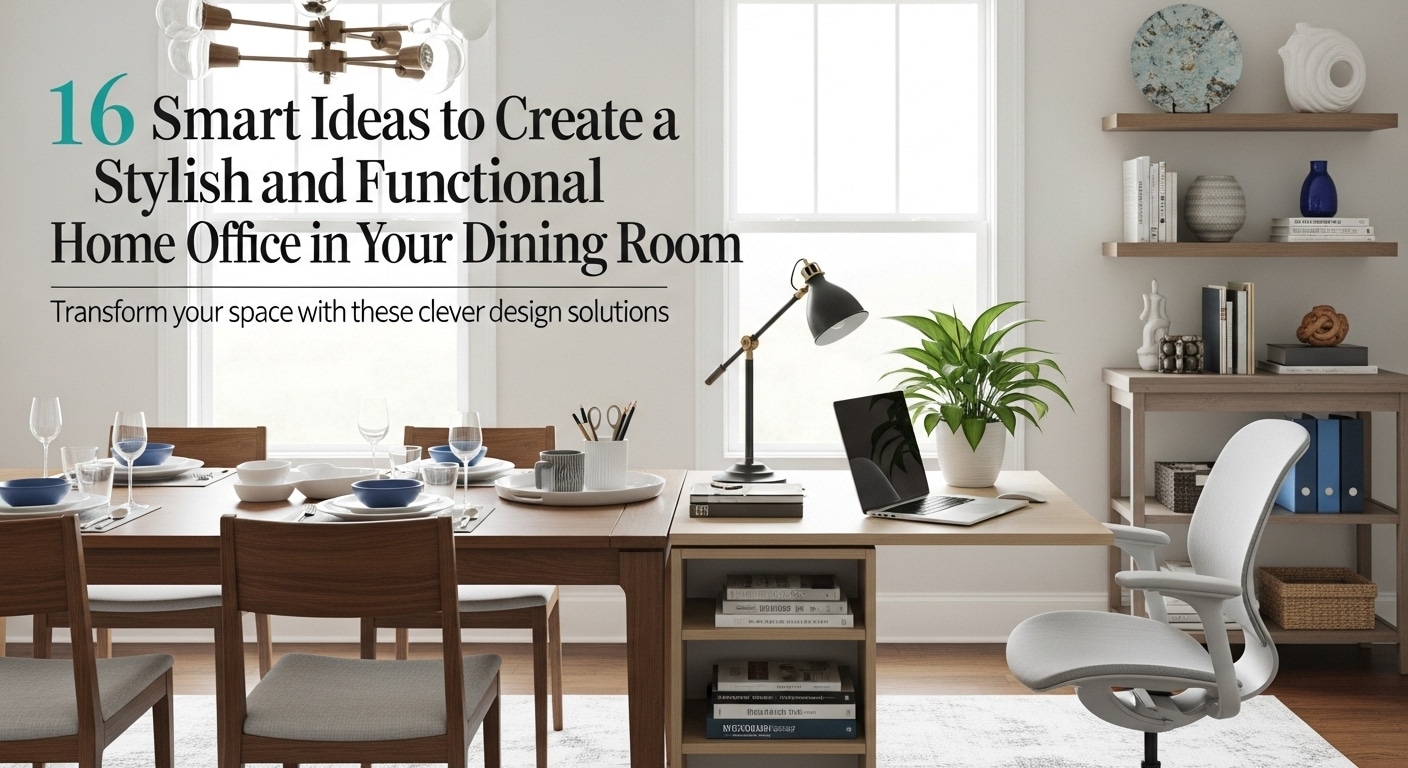The boundary between living spaces and workspaces continues to blur as we move deeper into 2025. With remote work firmly established as the new normal, many urban dwellers are facing a common dilemma: how to carve out a productive home office when square footage is at a premium. Your dining room, that sometimes neglected space, might just be the perfect canvas for your next workspace revolution.
The dining-office hybrid (or “doffice” as some interior designers have playfully dubbed it) has evolved from a makeshift pandemic solution into a sophisticated design challenge. No longer must you choose between a place to eat and a place to meet—today’s innovative solutions let you have your cake and work on spreadsheets too.
1. Convertible Smart Tables: The Heart of Your Dining-Office

The cornerstone of any successful dining room office is undoubtedly the table. In 2025, convertible smart tables have transcended their clunky predecessors. These engineering marvels transform from dining surfaces to ergonomic workstations with minimal effort.
Look for tables with built-in charging stations that wirelessly power your devices without unsightly cords. Some cutting-edge models feature adjustable heights that transition from dining to standing desk positions with voice commands or a gentle tap. The Ergo-Dine X7, for instance, includes subtle compartments that emerge from beneath the surface, revealing keyboard trays and pencil drawers that completely disappear when not in use.
Tables with nano-coated surfaces are especially worth the investment, they repel both coffee spills and fingerprints with equal vigor. Your guests will never guess that just hours earlier, you were conducting virtual meetings across the same surface where they’re now enjoying your famous pasta.
2. Double-Duty Seating That Doesn’t Scream “Office Chair”
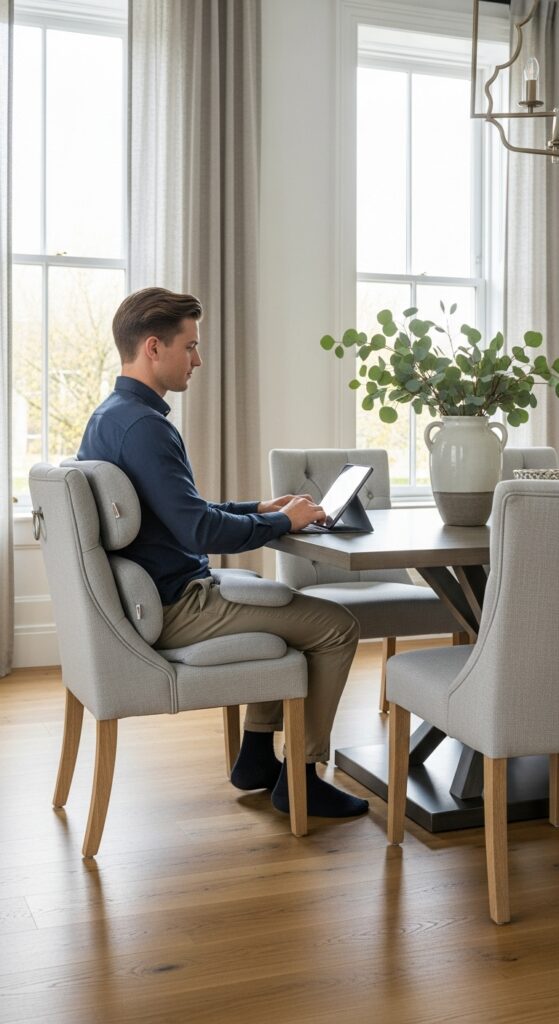
The ergonomic nightmares of 2020’s impromptu home offices are distant memories. Today’s dining chairs can support your lumbar region without looking like they were stolen from a corporate cubicle.
Consider the new generation of adaptive seating that changes firmness throughout the day. These intelligent chairs detect when you’ve been sitting too long and subtly shift to encourage movement and proper posture. For the style-conscious, brands like ModernNest and UrbanComfort offer dining chairs with concealed adjustment levers and removable ergonomic cushions that can be stowed when guests arrive.
For the ultimate flexibility, investigate modular chair systems with interchangeable components. The base remains constant while backs, cushions, and arms can be swapped to transition from work mode to dinner party ready in under five minutes. These ain’t your grandpa’s convertible furniture—they’re sophisticated chameleons for the modern multitasker.
3. Innovative Storage Solutions to Hide Work Clutter

Nothing kills a dining room’s ambiance faster than scattered work documents and tangled charging cables. The key to maintaining harmony in your dual-purpose space lies in clever storage that conceals the evidence of your 9-to-5 existence.
Wall-mounted cabinets with smart-locking systems can secure sensitive work materials while blending seamlessly with your dining room decor. Some forward-thinking designs feature false backs that slide open to reveal shallow storage for laptops and tablets—perfect for keeping technology close at hand but out of sight.
Don’t overlook the potential of bench seating with hidden compartments. These multipurpose marvels provide additional dining seating while housing office supplies, paperwork, or even a compact printer. The latest models incorporate biometric locks that ensure only you can access work materials, ideal for households with curious children or nosy houseguests who might accidentally stumble upon your confidential TPS reports.
4. Lighting That Adapts to Work and Dining Needs

The harsh overhead lighting that helps you scrutinize spreadsheets rarely creates the ambiance you want while enjoying a leisurely meal. In 2025, adaptive lighting systems have finally bridged this divide.
Look for programmable fixtures that transition between focused task lighting and warm ambient illumination with simple voice commands or scheduled presets. The most sophisticated systems integrate circadian rhythms, gradually shifting color temperature throughout your workday to optimize concentration and reduce eye strain.
Discrete task lamps disguised as decorative elements represent another lighting breakthrough. Companies like LumenCraft now offer table centerpieces that transform into directional work lights with a gentle touch. When folded down, these ingenius fixtures appear to be nothing more than attractive sculptures or vases—a perfect example of function hiding behind form.
5. Room Dividers That Define Without Constricting
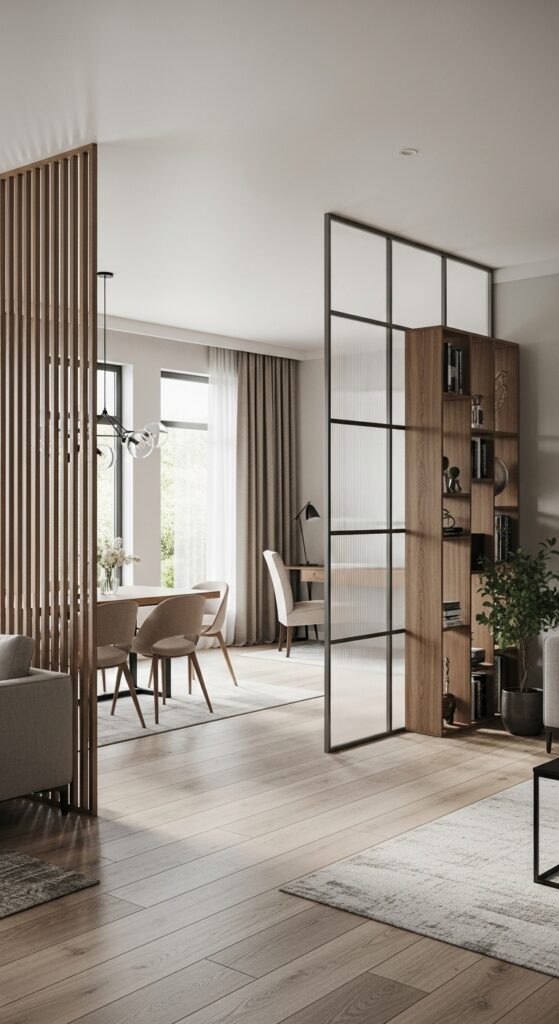
Creating psychological boundaries between work and dining zones helps maintain work-life balance, even when both activities share the same square footage. Modern room dividers have evolved well beyond folding screens to offer truly innovative space definition.
Programmable privacy glass panels that switch from transparent to opaque have become more affordable for residential use. These sleek dividers can separate your workspace during office hours, then turn crystal clear for dinner time, maintaining the room’s spacious feel while eliminating visual distractions.
For smaller spaces, consider ceiling-mounted retractable dividers that descend only when needed. The latest models incorporate sound-absorbing materials that improve acoustics for video calls, then roll away completely when your workday concludes. Some even double as projection surfaces for both work presentations and weekend movie nights—who wouldn’t appreciate that versatility?
6. Cable Management Systems That Actually Work

Nothing undermines a sophisticated dining space faster than a tangle of cables snaking across the floor. Thankfully, 2025’s cable management solutions make the rat’s nest of yesteryear completely unnecessary.
Furniture with integrated channeling now conceals charging cables within table legs and chair frames. These pathways guide necessary connections from floor to tabletop without visual disruption. For existing furniture, adhesive cable guides with decorative covers can be matched to your table finish, making power cords virtually disappear.
The most advanced dining tables now feature inductive charging zones embedded directly into the surface. These areas, often marked with subtle inlays or symbols, power compatible devices without any physical connection. Simply place your phone, tablet, or laptop atop the designated area, and charging begins automatically—no plugs, no fuss, no visual clutter to detract from your carefully plated dinner.
7. Acoustical Treatments Disguised as Décor

Video conferences and family meals require different acoustic environments. Modern solutions address this challenge without transforming your dining room into what looks like a recording studio.
Decorative sound-absorbing panels designed to resemble artwork have reached new heights of authenticity. These pieces feature custom-printed canvases stretched over acoustic foam, controlling echo during work calls while displaying family photos or fine art during dinner parties. Some manufacturers even offer seasonally changeable covers, allowing you to refresh your décor while maintaining acoustic functionality.
Ceiling medallions that incorporate sound-dampening materials represent another invisible acoustical intervention. These architectural elements frame light fixtures while improving room acoustics—guests will complement your designer ceiling detail, never realizing it’s actually helping absorb the reverb from your morning sales calls.
8. Smart Credenzas: The Workstation That Vanishes

The dining room sideboard or credenza has traditionally stored china and linens. In 2025, these pieces have evolved into sophisticated workstations that completely transform when needed.
Look for models with motorized components that reveal monitor mounts, keyboard trays, and filing systems with the press of a button. When work concludes, these elements retract, leaving only a handsome storage piece that complements your dining aesthetic. The transition occurs in seconds, making it practical to switch between functions multiple times daily.
Manufacturers like StealthDesk and HiddenOffice specialize in these transforming furnishings, offering customizable finishes and configurations to suit any dining room style. Their latest innovations include biometric security features and climate-controlled compartments for sensitive equipment—perfect for professionals who need to secure work materials quickly when transitioning to family time.
9. Flooring Solutions That Protect Against Chair Damage

The constant movement of office chairs can devastate beautiful dining room floors. Instead of compromising with ugly plastic mats, 2025 brings elegant solutions to this common problem.
Reversible area rugs with different textures on each side allow you to flip between a durable work surface and a more luxurious dining texture. These dual-personality coverings often feature different patterns on each side, effectively giving you two design options for seasonal changes or mood shifts.
For hardwood lovers, new micro-finish technologies create invisible protective zones that resist chair wheel damage without changing the floor’s appearance. Applied in specific areas where chair movement occurs most frequently, these treatments preserve your flooring’s integrity without visual compromise. You’ll never need to worry about those little wheel marks ruining your gorgeous hardwood again—a small improvement that makes a huge difference.
10. Color Psychology for Dual-Function Spaces
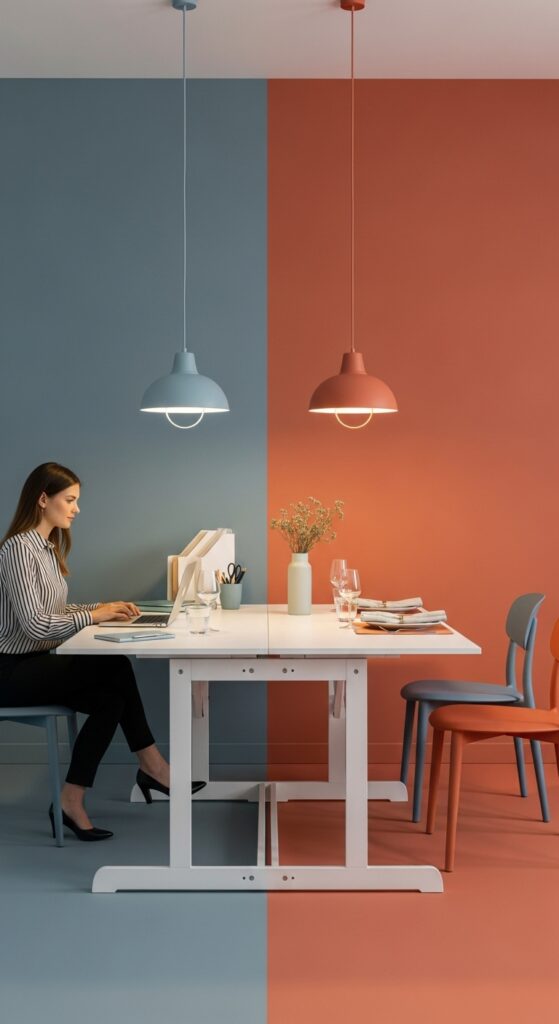
The colors surrounding us significantly impact both productivity and appetite—a challenging balance when one space serves both purposes. Contemporary designers have developed sophisticated approaches to this dilemma.
Consider using dynamic paint systems that subtly shift hues throughout the day. These programmable finishes can display cooler, focus-enhancing tones during work hours, then warm to appetite-stimulating shades for mealtime. While the technology remains somewhat pricey, many homeowners find the versatility worth the investment.
For more budget-conscious renovators, strategic color blocking provides a simpler solution. Using slightly different tones to define work versus dining zones creates psychological boundaries without physical barriers. The colors should compliment each other while providing enough contrast to signal different functions to your brain—tricking your mind into seeing two rooms where only one exists.
11. Multifunctional Wall Systems Beyond Simple Shelving

Walls represent vastly underutilized real estate in most dining rooms. Modern wall systems transform these vertical surfaces into hardworking elements of your dining-office hybrid.
Modular panel systems with interchangeable components allow walls to adapt throughout the day. Swap document holders and monitor mounts for wine racks and decorative elements when transitioning from work to dining. The best systems utilize standardized mounting brackets hidden behind panels, ensuring that changes require no tools and leave no visible hardware.
For the tech-forward, interactive wall surfaces combine touchscreen functionality with decorative elements. These smart walls can display digital artwork during dinner, then transform into productivity dashboards during work hours. While still emerging, this technology has become increasingly affordable as major manufacturers compete for the growing home-office market.
12. Air Quality Management for All-Day Spaces

Spending both work and leisure hours in the same room raises concerns about air quality and circulation. Fortunately, integrated environmental systems have advanced significantly.
Look for discreet air purification systems built into decorative objects or furniture. Table centerpieces with HEPA filtration quietly clean your air throughout the day, removing allergens and particulates without disrupting either work or meals. These silent guardians often incorporate subtle aromatherapy features, transitioning from focus-enhancing scents during work hours to appetite-complementing fragrances at mealtime.
Climate zoning has also become more accessible for single rooms. Targeted heating and cooling systems direct airflow precisely where needed, allowing you to maintain ideal working temperatures without chilling dining guests. These micro-climate solutions use significantly less energy than whole-home systems—helping both your comfort and your utility bills.
13. Dedicated Tech Zones Within Arm’s Reach

Even the most minimalist worker requires certain technology within reach. Creating a dedicated tech zone prevents devices from sprawling across your entire dining surface.
Consider integrating a rotating panel into your table design—one side finished to match your dining surface, the other equipped with charging ports, small screens, and controls. A simple turn reveals your tech command center when needed, then conceals it during meals. The mechanism should be smooth and quiet, allowing quick transitions without disrupting the room’s ambiance.
Alternatively, explore furniture with designated technology drawers featuring built-in power and cable management. These specialized compartments keep devices charged and ready while containing cables and accessories. The most innovative designs incorporate cooling systems to prevent overheating during charging—a thoughtful touch that protects both your devices and your furniture.
14. Biophilic Elements That Improve Both Work and Dining

Research consistently demonstrates that natural elements enhance both productivity and dining experiences. Integrating biophilic design into your dual-purpose space benefits both functions simultaneously.
Living walls that double as sound absorption panels represent the pinnacle of this approach. These vertical gardens improve air quality, dampen noise, and provide psychological benefits during work hours, then create a relaxing backdrop for meals. New self-maintaining systems with built-in irrigation and lighting have made these features much more practical for residential settings.
For less ambitious implementations, consider smart planters that optimize growing conditions for each plant variety. These connected containers monitor soil moisture, light levels, and nutrient needs, ensuring your greenery thrives with minimal intervention. Some models even include air quality sensors that display pollution levels and automatically increase filtration activity when needed—bringing both beauty and function to your dining workspace.
15. Integrated Meditation/Relaxation Corners
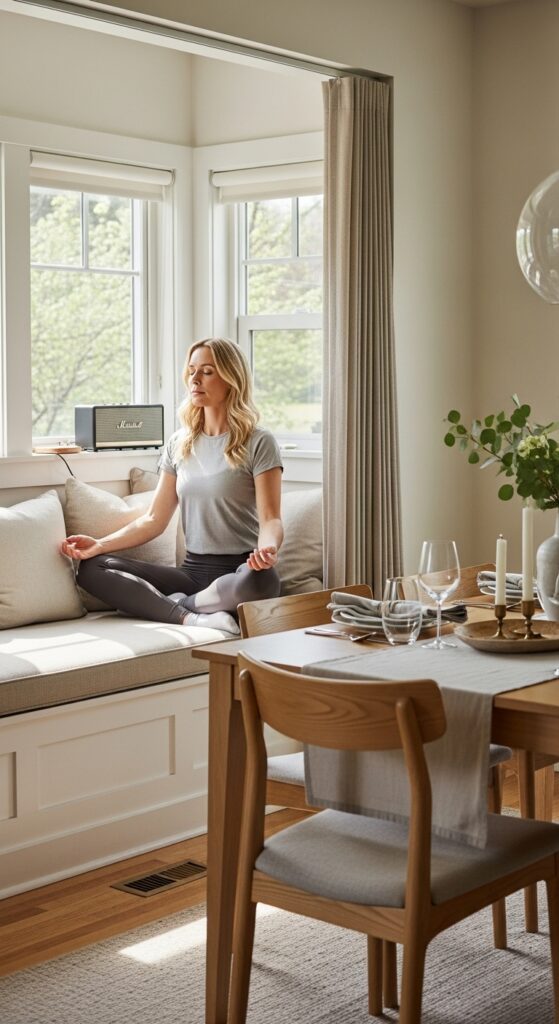
Mental breaks enhance productivity, but completely leaving your workspace isn’t always practical. Forward-thinking dining-office designs now incorporate dedicated relaxation zones within the same room.
Window seats with adjustable privacy screens create perfect meditation nooks that serve double duty as additional dining seating when guests arrive. These thoughtful installations often feature built-in speakers for guided meditations or nature sounds, helping you reset between tasks without leaving your multipurpose room.
For spaces without suitable windows, consider freestanding relaxation pods with programable lighting and sound. These compact wellness stations occupy minimal floor space while providing crucial mental refreshment throughout your workday. When evening arrives, they transform into ambient lighting features that enhance your dining atmosphere—proving that wellness elements can seamlessly integrate into any dual-purpose design.
16. Social Consideration: Making Video Calls Less Intrusive

Remote work inevitably means video meetings, which can disrupt household harmony when conducted in shared spaces. Thoughtful dining room office designs address this reality with specialized solutions.
Backdrop systems that deploy from ceiling tracks provide professional backgrounds during video calls without permanent installation. These retractable screens display neutral or branded backgrounds during meetings, then disappear completely when work concludes. The most sophisticated versions include acoustic properties that improve call quality while reducing noise transmission to the rest of your home.
For those sharing space with family members, directional microphones and speakers focus audio precisely where needed. These targeted sound systems allow you to participate in calls without broadcasting conversations throughout your home. When paired with privacy screens, they create an invisible audio bubble that minimizes disruption for others using adjacent spaces—maintaining household harmony even during your busiest workdays.
Conclusion: The Seamless Integration of Work and Life
As we navigate deeper into 2025, the distinction between dedicated workspaces and living areas continues to evolve. Today’s dining room office solutions no longer represent compromise but rather intentional design that enhances both functions. The most successful implementations acknowledge the psychological importance of transitions, creating spaces that support focused work and relaxed dining with equal consideration.
The 16 ideas presented here offer pathways to create a space that honors both productivity and pleasure. Whether you’re retrofitting an existing dining room or designing from scratch, these strategies provide framework for thoughtful integration. Remember that personalisation remains essential—the perfect dining room office reflects your unique work style and entertaining needs.
As remote work becomes increasingly sophisticated, our homes must evolve accordingly. The dining room office exemplifies this adaptation, transforming a sometimes underutilized space into the heart of both productivity and hospitality. With careful planning and these innovative solutions, your dining room can become the most versatile, beautiful, and functional room in your entire home—truly the best of both worlds.

Mariana is the founder and voice behind Home Nookery, a curated blog dedicated to home design, décor inspiration, and cozy living. With a passion for creating beautiful, functional spaces, Mariana shares practical tips, styling ideas, and thoughtful insights to help readers turn their houses into homes. Whether you’re redesigning a room or just adding a touch of charm, she’s here to guide you with creativity and heart.
